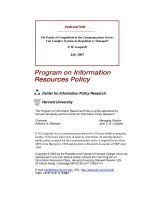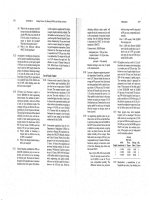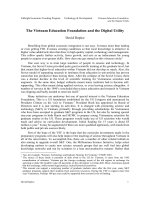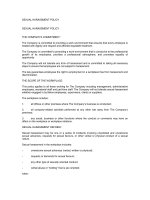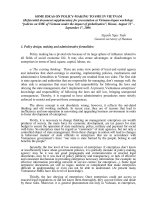Education policy vuhoangdung 1710077
Bạn đang xem bản rút gọn của tài liệu. Xem và tải ngay bản đầy đủ của tài liệu tại đây (766.06 KB, 13 trang )
Chapter 3:
Educational finance
Content
1. Educational Financing
in the Prewar Period
2. Postwar Educational
Financing
3. The Educational
Financing Reform Debate
in the National Council on
Educational Reform
4. Conclusion
2
Issues:
Secure sources of finance => educational financing
policies
effective use of fund,
prioritized distribution,
diversification of sources of funding provision,
private funding
3
Points:
Provide an overview of the history and current state of
educational financing in Japan.
How responsibility for the provision of funding among
national government, prefectural governments, cities,
towns and villages, parents, and community residents
Educational finance – a significantly decentralized system
The movements to expand government subsidies to
specific educational areas
4
1. Educational Financing in
the Prewar Period
1-1 Large-scale Dependence on Community
Residents and Parents
1-2 Unification of the Educational Financing Burden
Levied on Municipalities, and Movements to Begin
(restart) the System of Central Government
Subsidies
1-3 A Legal Base for the National Treasury’s Share
of Compulsory Education Expenses
5
2. Postwar Educational
Financing
2-1
Postwar Reconstruction and Educational
Financing
2-2 Aid for Private Schools
2-3 The Enactment of the Laws to Promote
Various Priority Measures and the
Establishment of Financial Support for
Specific Target Areas
2-4 Securing Capable Personnel and
Improving Teachers’ Salaries
6
3. The Educational Financing Reform
Debate in the National Council on
Educational
Reform
(1)
A new division
of roles between the
public and private sector and a system of
cooperation
(2) Strengthening of educational finance and
prioritized distribution
(3) Rationalization and increased efficiency
in educational finance
(4) Exploiting private-sector vitality
(5) Reducing the burden on households of
educational expenditure
7
8
9
10
11
4. Conclusion
● Educational administration - highly centralized character
● Educational finance - a relatively decentralized system
● In principle, central government did not contribute to the costs
of compulsory education, but in practice there was a gradual
expansion of disbursements by the national treasury in the form
ofassistance given on an exceptional basis for specific purposes
such as the construction of school buildings or improvements in
teachers’ salaries.
● Through the enactment of a series of laws designed to promote
specific aims, the government can provide financial assistance
for defined objectives.
12
Thanks!
Any questions?
13
